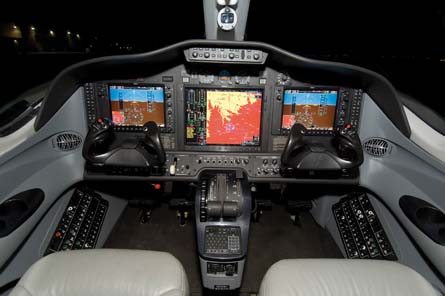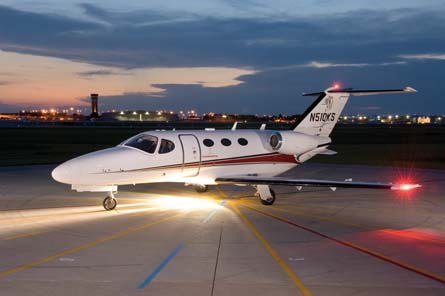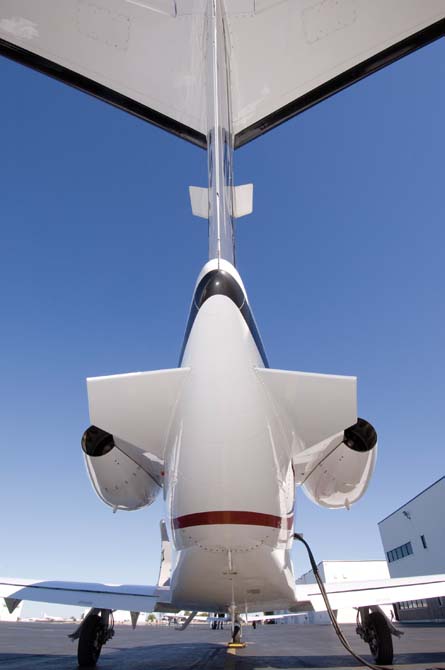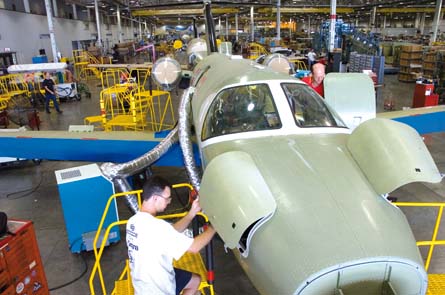Cessna has aimed its Mustang entry-level jet at operators of piston and turboprop aircraft looking at a low-cost way to get into the turbofan market
Availability of jets costing between $1 million and $3 million has electrified the general aviation marketplace, but this is not the first time jets have invaded territory held by propeller-driven aircraft. Three decades ago, Cessna introduced an eight-seat twinjet that could fly more than 2,000km (1,100nm) at almost 350kt (650km/h) and which cost $2.3 million at today's prices. That aircraft, the Citation 500, launched the most successful family of business jets in the industry.
Garmin's G1000 avionics brought cost and weight savings |
Cessna's first jet was aimed at operators of piston twins and turboprops. Twenty years later, the manufacturer returned to the entry-level business jet market tapped by the Citation 500 with its introduction of the CitationJet. Now Cessna has lowered the barrier to entry to its business jet family even further with the six-seat Mustang, which can fly 2,130km at 340kt and costs $2.6 million - almost $2 million less than the latest incarnation of the CitationJet, the CJ1+.
Launched in 2002, the Model 510 Citation Mustang is an all-new design aimed at customers who operate piston twins, single-engine turboprops and smaller turboprop twins, but for whom a CJ1+ is too big a step. That made handling qualities, as much as price, a design driver. "We built the Mustang to be docile, with slow stall speeds and good characteristics," says programme manager Russ Meyer III.
Mustang is all-new but clearly a Citation. New oval windows make four-seat cabin lighter |
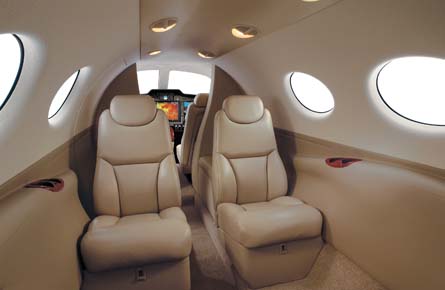 |
Although it fits within the industry's definition of a very-light jet (VLJ) because its maximum take-off weight is below 4,540kg (10,000lb), Cessna calls the Mustang an entry-level jet because it sits at the bottom of its Citation range and opens the market to a larger customer base, including owners moving up its single-turboprop Caravan.
"Looking at the market we saw owner/operators moving out of lesser-technology, smaller aircraft, so we looked at safety as being key. All Citations have good handling and are easy to fly, and we carried that forward," says Meyer. "We did a lot of testing in the windtunnel to get the best stall characteristics."
After looking at a wide range of concepts for an aircraft to fit between the Caravan and Citation range, Cessna settled on a small twinjet. "We talked to a lot of customers, and the sweet spot was for an entry-level jet," says programme engineer John Carr. "We needed to produce an extremely reliable aircraft, so we went for the reliability and safety of twin turbofans."
At first glance, the Mustang looks like a scaled-down CitationJet, but it is a new design. Despite 11° of leading-edge sweep, the wing is essentially straight and has a new Cessna-designed high-lift aerofoil section to reduce stall speeds while minimising drag in high-speed cruise. "Stall speed is in the upper 60s [knots] at light weight and low 70s at heavier weights," says Carr.
A clean-sheet design was necessary to achieve a price point well below other Citations, as it allowed Cessna to design the Mustang's structure and systems for the lowest cost. "We came up with a price point for this market in 2002 and we are still at the same price today - $2.395 million plus CPI [consumer price index]," says Roy Lawson, product marketing manager.
At the same time as reducing cost, Cessna aimed for high reliability. "We looked at our existing aircraft, and worked with our service organisation, and have improved reliability across the board," says Carr.
Low cost, high reliability
With the goals of low cost and high reliability, rather than simply carrying systems and suppliers over from other Citations, Cessna conducted a full competition. This led to the Mustang becoming launch application for Pratt & Whitney Canada's PW600 small turbofan and Garmin International's G1000 integrated avionics - both bringingmajor cost savings over previous products.
Selecting Garmin was a departure from Cessna's tradition of installing Honeywell/Bendix-King or Rockwell Collins avionics, and was based on both the price and capability of the panel-mounted G1000. Although Cessna certificated Garmin's system first in its single-engine aircraft, "the Mustang was the first customer", says Carr, adding: "The G1000 brings big cost savings, and fairly significant weight savings, and in some cases does a lot more than other avionics."
Garmin provides almost the complete avionics suite for the Mustang, including the two 10.4in (265mm)-diagonal liquid-crystal primary flight displays and central 15in multi-function display, which hosts a moving map and engine indication and crew alerting system. The G1000 includes dual solid-state digital air-data computers and attitude/heading reference systems the dual communication and navigation radios and dual WAAS-capable GPS receivers, which provide satellite-based position data to the single flight management system (FMS). Garmin also supplies the Mustang's three-axis autopilot, colour weather radar, Mode S transponders and XM Satellite weather datalink. Standard features of the G1000 include traffic information system and a Class B terrain awareness warning system, as well as diagnostics and maintenance. Standby instruments are provided by Aerosonic and Mid Continent Instruments.
"Garmin had the system pretty much designed when we selected it, but it was not built for a jet, so we worked with them to make changes and add things," says Carr. This included design of the FMS control keyboard on the pedestal, and the addition of a separate autopilot mode controller. "We are ecstatic with the result," say Meyer.
P&WC's 1,350lb-thrust (6kN) PW615F (see P59) was selected because of its low cost, weight and specific fuel consumption, says Carr. The two dual-channel full authority digital engine controls are mounted not in the nacelles but inside the tailcone, on the aft pressure bulkhead, where it is cooler and there is less vibration, improving reliability.
Simpler systems
One way Cessna sought to reduce the Mustang's cost was to simplify its systems. In the hydraulics, the usual engine-driven pumps have been eliminated and replaced with an electric pump that operates intermittently to charge an accumulator that provides hydraulic pressure to operate the landing gear and power the brakes. Two independent pneumatic systems provide for emergency gear extension and braking.
"The CJ has to have a power pack to run the brakes before engine start," says Carr. "When we sized the Mustang's landing gear actuators, we found we could double the flow of the existing power pack to do the job. We saved weight, cut the leak paths in the hydraulics by 50% and improved reliability and maintainability," he says. Flaps and speed brakes are electrically driven, the flaps by a single motor in the belly while the speed-brake panels extend above and below the wing via scissor-style actuators.
Two engine-driven starter/generators power the electrical system, with a lead-acid battery for engine starting and limited backup. The fuel system has one integral tank per wing, each supplying its respective engine and a total usable capacity of 1,170kg. Ice protection is by pneumatic boots on the wing and tail, bleed air on the engine inlets, and electrically heated windshields and pitot-static sensors.
While the flight controls are similar to those in other Citations, the Mustang's control yokes are panel-mounted, eliminating cables and making installation easier and the system more reliable. Most of the avionics are panel-mounted, making them cheaper and easier to install and maintain, says Carr, adding: "We put a mean time between unscheduled removals goal into everything we did in selecting suppliers and designing systems. Every request for proposals stated cost and reliability goals."
Flight testing of the Mustang began in April 2005 and involved one prototype and two pre-production aircraft. Design changes made during flight tests include the addition of two strakes under the tailcone. These generate a stronger nose-down pitching moment at high angle of attack and, by increasing the force required to pull back on the yoke, make it clear to the pilot when the aircraft is being "abused".
Other changes came late in the programme, and are designed to improve directional control and stall behaviour in icing. These include the fitting of a de-icing boot to the leading edge of the vertical stabiliser, in addition to the wing and horizontal stabiliser, and the attachment of vortex generators (VG) to the leading edge of the wing.
Preventing stalls
The so-called Wheeler VGs - vee-shaped ramps - were added to control stall propagation. For controllability, a stall needs to begin on the inboard wing and spread outboard, but with the de-icing boots going all the way to the wing root, Cessna could not put stall strips inboard where they would shed ice into the engines. So the VGs were added to the outboard leading edges to drive the stall inboard. "They force stall control into the wing," says Carr, "and there is no measurable performance hit."
Strakes were added under the tail to help prevent stalls |
US type certification was received in September, and approval for flight into known icing is expected before deliveries begin. The Mustang has met its performance goals, in some cases exceeded original projections, says Meyer, adding: "There is a significant improvement in landing distance at maximum landing weight, and some improvement in take-off distance."
The aircraft is certificated to Part 23, and its performance to more demanding Part 23 commuter rules - "the same rules as some of the larger Citations, and the same as the airlines use. This provides a distinct safety advantage," says Carr. European approval is expected in the latter part of next year, before delivery of aircraft number 35.
Production is ramping up at the Independence, Kansas plant opened in 1995 to build Cessna's piston singles. This was chosen because the main Wichita plant did not have the capacity to build the Mustang in the volume expected, but also because the Independence workforce is used to building essentially standard aircraft, rather than the customised jets Wichita produces. With a standard four-seat cabin and limited avionics and interior options, the Mustang "will be the same every time", says Meyer.
The aluminium airframe makes extensive use of metal bonding, a process with which Cessna is familiar, but its assembly is more modular than other Citations, says Mark Ahne, manufacturing manager. Hydroformed and skin bonded panels are built up in vacuum tooling, producing a smooth exterior finish, and the subassemblies are stuffed before mating, while access is easier. The fuselage is made up of four subassemblies: nose, cockpit to just aft of the door, cabin to the aft pressure bulkhead, and tailcone.
The "real leap" for Cessna, says Ahne, is the use of machined monolithic spars in the wing and tail, and the move from traditional built-up spars only came after "a lot of testing to understand and predict crack propagation". The three-spar wing is built in two pieces and joined at the centreline, the spars "pinched" to fit under the fuselage, and is totally self-contained. In full-rate production, the landing gear will be installed, rigged and swung, the ailerons, flaps and speed brakes fitted and tested, and the fuel tanks leak-checked and probes calibrated before wing and fuselage are mated, he says.
Modular assembly speeds production at Independence plant |
Order backlog
Customer deliveries are to begin in February and Cessna expects to hand over around 40 Mustangs next year and up to 100 in 2008, against an order backlog of more than 250 aircraft. Accelerating reliability testing is now under way following certification. "We are flying all the time, working the systems to understand the aircraft before it gets to the customer," says Meyer, adding: "We completed function and reliability testing [for certification] with 100% despatch reliability."
Training is getting under way at partner FlightSafety International, including the first proficiency checks to determine what, if any, extra instruction pilots will need. "The proficiency index will inventory the pilot's experience," says Lawson, and is a key to assuring the safety of VLJs. Another is the curriculum-based mentoring available after type rating, in which an instructor will take the newly trained pilot through specific flight profiles, such as a high-altitude mission, to ensure proficiency.
About 85% of orders are from owner/operators, with a "very small number" from charter and fractional companies and none from air taxis, says Lawson, who adds there are Fortune 100 companies looking at using the Mustang as a "corporate limousine" for middle managers: "But we have not completed any transactions yet." The first aircraft, meanwhile, will go to the owner of a Cessna 310 piston twin, which shows that, as an entry-level jet, the Mustang is hitting the mark.
Source: Flight International





















